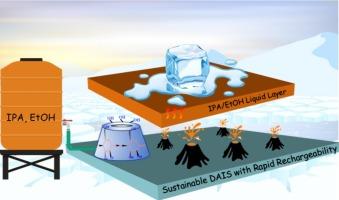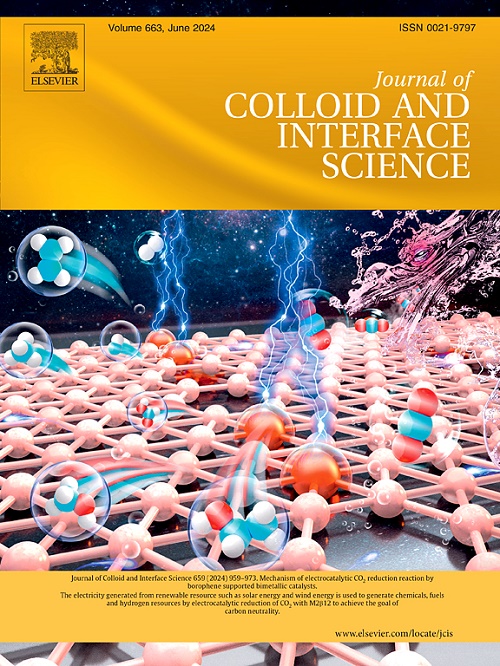假设:具有快速充电潜力的可持续动态防冰表面
IF 9.7
1区 化学
Q1 CHEMISTRY, PHYSICAL
引用次数: 0
摘要
积冰给众多行业带来了巨大挑战。虽然动态防冰表面(DAIS)在减少冰的形成和附着方面已显示出潜力,但其实际使用往往受到液体快速扩散和缺乏可重复使用性的限制。克服这些限制对于解决与冰管理相关的环境和经济问题至关重要。在本研究中,我们引入了一种新方法,将 β-环糊精(β-CD)融入聚二甲基硅氧烷(PDMS)硅橡胶中,从而创造出一种具有快速充电潜力的可持续 DAIS。β-CD 外表面的多个羟基促进了偶极-偶极相互作用和氢键,特别是与乙醇和异丙醇等极性分子的相互作用和氢键。这使表面变成了一个可充电系统,能够在补充液体后 10 分钟内恢复其低冰粘附功能。当表面结冰时,系统会通过浓度梯度对环境变化做出动态响应,控制液体的释放并改变表面特性。这些滞留的液体能有效降低冰点,融化冰层,破坏冰层结构,将固液界面转化为液液界面。DAIS 有效地改变了冰与基底的相互作用,提高了在-18 ℃低温下的性能。通过优化 β-CD 质量比和液体处理,特别是异丙醇处理,我们获得了 0.6 kPa 的超低冰粘附强度,即使在 35 天后也能保持稳定。这项研究在开发可持续、快速充电的 DAIS 方面取得了重大进展,为各行各业的应用提供了巨大潜力。本文章由计算机程序翻译,如有差异,请以英文原文为准。

Hypothesis: A sustainable dynamic anti-icing surface with the potential for rapid rechargeability
Ice accumulation poses significant challenges across numerous industries. While dynamic anti-icing surfaces (DAIS) have shown potential in mitigating ice formation and adhesion, their practical use is often limited by the rapid diffusion of liquids and lack of reusability. Overcoming these limitations is crucial to addressing the environmental and economic issues related to ice management. In this study, we introduce a novel approach by incorporating β-cyclodextrin (β-CD) into polydimethylsiloxane (PDMS) silicone rubber, enabling the creation of a sustainable DAIS with the potential of rapid rechargeability. The multiple hydroxyl groups present on the outer surface of β-CD facilitate dipole–dipole interactions and hydrogen bonding, particularly with polar molecules like ethanol and isopropanol. This transforms the surface into a rechargeable system, capable of restoring its low ice adhesion functionality within just 10 min after liquid replenishment. When ice forms on the surface, the system dynamically responds to environmental changes via concentration gradients, controlling the release of liquids and altering surface characteristics. These retained liquids effectively lower the freezing point, melt the ice, and disrupt the ice structure, converting the solid–liquid interface into a liquid–liquid interface. The DAIS effectively alter the ice-substrate interaction and enhance performance at temperatures as low as −18 ℃. By optimizing the β-CD mass ratio and liquid treatments, especially with isopropanol, we achieved an ultra-low ice adhesion strength of 0.6 kPa, which remains stable even after 35 days. This study presents a significant advancement in the development of sustainable, rapidly rechargeable DAIS, offering immense potential for applications in various industries.
求助全文
通过发布文献求助,成功后即可免费获取论文全文。
去求助
来源期刊
CiteScore
16.10
自引率
7.10%
发文量
2568
审稿时长
2 months
期刊介绍:
The Journal of Colloid and Interface Science publishes original research findings on the fundamental principles of colloid and interface science, as well as innovative applications in various fields. The criteria for publication include impact, quality, novelty, and originality.
Emphasis:
The journal emphasizes fundamental scientific innovation within the following categories:
A.Colloidal Materials and Nanomaterials
B.Soft Colloidal and Self-Assembly Systems
C.Adsorption, Catalysis, and Electrochemistry
D.Interfacial Processes, Capillarity, and Wetting
E.Biomaterials and Nanomedicine
F.Energy Conversion and Storage, and Environmental Technologies

 求助内容:
求助内容: 应助结果提醒方式:
应助结果提醒方式:


